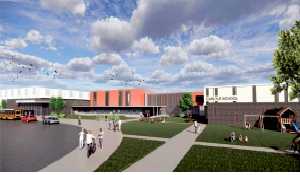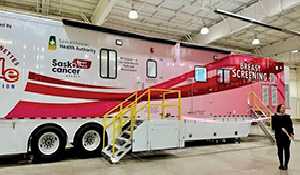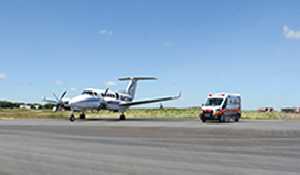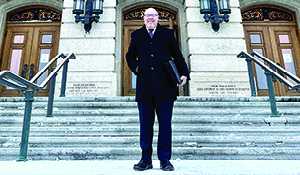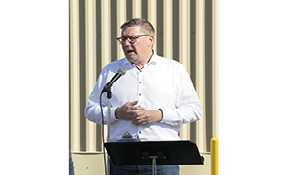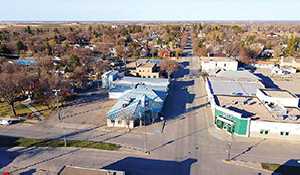Tentative agreement reached between CUPE and Town of Esterhazy
August 4, 2025, 10:41 am
Ryan Kiedrowski, Local Journalism Initiative Reporter

As bargaining talks between the Town of Esterhazy and CUPE Local 5428 resumed on July 22, there’s renewed confidence that a solution is forthcoming. While details of those meetings are not yet available, CUPE national staff representative Dyland Breland noted ‘big updates’ when asked for comment by the World-Spectator, that a tentative agreement has been reached.
“We’re thankful the employer moved off their concessionary demands,” Breland said. “We spent the day bargaining, and we were able to achieve what’s called a tentative agreement at the bargaining table. We brought that agreement back to the general membership for a vote on Thursday, July 24 and the membership voted in favour of ratification, and we’re waiting on Town Council to meet and have their vote for ratification, which would conclude bargaining.”
Town Council meets
With no regular meeting of Council scheduled until Aug. 21, a special meeting was called regarding the agreement on July 28, which both the Union and Town agreed went smoothly.
“We had a special meeting yesterday, so everything was ratified during that so we’ll be moving forward,” said Esterhazy Mayor Randy Bot. “I want the employees to be happy and to know that we support them from the Mayor and Council and staff aspect. We support them, and we know their worth to the community.”
On the negotiations overall, Breland acknowledged how the relationship has improved around the bargaining table.
“There’s certainly members of Council who seem to really want to move forward meaningfully with improving labor relations,” he said. “Certainly Mayor Randy Bot has had a fair bit of interaction with the union, with the members directly. He’s interested in solving problems. (Councillor) Dana Paidel was a member of the employer’s bargaining committee and has taken an active role to improve labour relations. So certainly, they have some positive results.”
Now the goal is to maintain that positive connection going forward.
“Everybody’s happy,” Bot said. “That’s my main concern is to have a community with the workers, having a good morale and being happy to come to work at the Town of Esterhazy.”
“We certainly have the ability to move forward in a very productive, collaborative way,” Breland said. “That’s certainly how bargaining from our point of view concluded, so we’re looking to maintain and grow that relationship.”
The issues
One sticking point through initial negotiations was that of seniority where the union wanted to see a change to it being based on hire date instead of an hours worked system as an arbitrator had previously instilled to the collective agreement. Phasing out the Finance Officer position and proposing to add a Town Foreman role was another point of contention.
“We certainly met with Council earlier in the year here, around May,” Breland said. “We wanted to address our concerns. The employer was looking to carve out positions from scope, from the group of the union, essentially, which we were not willing to agree to at the table.”
Certain leaves from work such as maternity, paternity, or short-term disability would also mean a loss of seniority—something the union was not in favour of. Average length of seniority had also dipped below an average of four years per member.
“It would be a big step backwards, and certainly from our view, discriminatory,” Breland said. “If folks had to access any of those leaves, they would be essentially bumped down the seniority list for protected grounds. Those were our lines in the sand, essentially. We can’t agree to those kinds of concessions at the table. We messaged that to them in March, the employer tried forcing a vote on the offer in April, and that vote was rejected. So between that and the public awareness campaign to engage with the public and to rally public support, it to seemed to have convinced the employer to move off.”
However, during recent negotiations, seniority was not addressed by CUPE representatives.
“They came back to the table and they didn’t even bring it up,” Bot said. “The language stayed exactly the same, they thought it over, I guess, and didn’t feel like it needed to change. So it stayed.”
Previously, the Town also offered a 14 per cent wage increase over the course of five years (2.8 per cent every year), where the union was seeking three years.
“They wanted three, and we wanted a five, but we sat down and we settled for four, which is really good,” Bot said. “I think that everybody just came together with an open mind, level-headed approach and we just got it done. The contract is both good for our employees and for our taxpayers, and that was our goal from the beginning—to make sure that it’s a fair deal for everybody on both sides.”
Now that both CUPE and the Town of Esterhazy have voted on the ratification, next steps include officially signing the agreement, which will be in effect until 2027.
Workers were close to walking out
Back in March, over 80 per cent of the CUPE 5428 employees voted in favour of job action. Citing an agreement that expired at the end of 2023 and previous talks not making headway, it marked the second time both sides hit the bargaining table since members from the Town of Esterhazy joined CUPE in 2019. There were four days of negotiations in November of 2024 and three in March, with mediation not far off.
There are 11 permanent Town staff that are members of CUPE through the departments of Utilities, Public Works, Parks and Recreation, and Administration.


